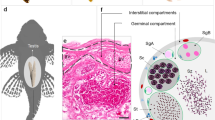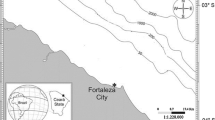Abstract
Cubozoa jellyfish species exhibit either internal or external fertilization, and reproductive behavior involving spermcasting or complex copulatory sexual behavior, but male gonad morphology has not been investigated broadly in cubozoans. In this study, a histological comparison was conducted of the testes of four cubozoan species in two orders: Carybdea marsupialis (Carybdeidae), Morbakka virulenta (Carukiidae), and Tamoya cf. haplonema (Tamoyidae) in Carybdeida and Chiropsalmus quadrumanus (Chiropsalmidae) in Chirodropida. Our results show spermatic follicles present in all species, with spermatogenesis occurring in two layers, the gastrodermis and the gonadal mesoglea. Specimens were either immature males or unspawned males, except in the case of Tamoya cf. haplonema which displayed rupture sites in the wall of the follicles, indicating prior release of sperm. Interspecific comparative histological study revealed that spermatogenesis generally occurs in a polarized manner towards the lumen of the spermatic follicle, with mature spermatozoa in the center awaiting gonadal rupture and release for either internal or external fertilization. Furthermore, we provide a synopsis of the histological findings to date on cubozoan testes, emphasizing incidences of conserved male gonad morphology regardless of mode of fertilization, in addition to separate novelties that have arisen in two internally fertilizing lineages, each exhibiting unique reproductive behavior. Further taxon-sampling of additional species at different development stages may reveal a broader diversity in testes morphology across Cubozoa and serve as a basis for a deeper investigation into the emergence of novel modes of sexual reproduction in non-bilaterian animals.







Similar content being viewed by others
References
Arkhipkin, A.I. (1992) Reproductive System Structure, Development and Function in Cephalopods with a New General Scale for Maturity Stages. Journal of Northwest Atlantic Fishery Science 12:63-74
Arneson, A.C. (1976). Life History of Carybdea alata Reynaud, 1830 (Cubomedusae). PhD thesis, Universidad de Puerto Rico.
Arneson, A.C. & Cutress C.E. (1976). Life history of Carybdea Reynaud, 1830 (Cubomedusae). In Mackie, G. O. (Ed.), Coelenterate ecology and behavior (pp.227–236). New York
Avian, M., Bonivento, P., Montanari, G., Rinaldi, A., & Rottini Sandrini, L. (1993). Carybdea marsupialis L. (Cubozoa), istologia delle gonadi. Biologia Marina Suppl Notiz SIBM, 1, 75–78.
Bancroft, J., & Stevens, A. (1982). Theory and practice of histological techniques. London: Churchill Livingstone.
Behmer, O. A., Tolosa, E. M. C., & Freitas Neto, A. G. (1976). Manual de tecnicas para histologia normal e patologica. São Paulo: Livraria Editora.
Bentlage, B., Peterson, A. T., & Cartwright, P. (2009). Inferring distributions of chirodropid box-jellyfishes (Cnidaria: Cubozoa) in geographic and ecological space using ecological niche modeling. Marine Ecology Progress Series, 384, 121–133.
Bentlage, B., Cartwright, P., Yanagihara, A. A., Lewis, C., Richards, G. S., & Collins, A. G. (2010). Evolution of box jellyfish (Cnidaria: Cubozoa), a group of highly toxic invertebrates. Proceedings of the Royal Society of London B: Biological Sciences, 277, 493–501.
Brinkman, D. L., Jia, X., Potriquet, J., Kumar, D., Dash, D., Kvaskoff, D., & Mulvenna, J. (2015). Transcriptome and venom proteome of the box jellyfish Chironex fleckeri. BMC Genomics, 16, 1–15.
Calder, D.R. (2009). Cubozoan and scyphozoan jellyfishes of the Carolinian biogeographic province, southeastern USA. Royal Ontario Museum.
Campbell, R. D. (1974). Cnidaria. In A. C. Giese & J. S. Pearse (Eds.), Reproduction of Marine Invertebrates, Acoelomate and Pseudocoelomate Metazoans (I ed., pp. 133–199). New York: Academic Press.
Collins, A.G. (2009). Recent insights into cnidarian phylogeny. In: Smithsonian contributions to marine sciences, 139–49.
Collins, A. G., Schuchert, P., Marques, A. C., Jankowski, T., Medina, M., & Schierwater, B. (2006). Medusozoan phylogeny and character evolution clarified by new large and small subunit rDNA data and an assessment of the utility of phylogenetic mixture models. Systematic Biology, 55(1), 97–115.
Corbelli, A., Avian, M., Marotta, R., & Ferraguti, M. (2003). The spermatozoon of Carybdea marsupialis. Invertebrate Reproduction and Development, 43(2), 95–104.
Fautin, D. G. (2002). Reproduction of Cnidaria. Canadian Journal of Zoology, 80(1), 1735–1754.
Fenner, P. J., Lippmann, J., & Gershwin, L. A. (2010). Fatal and nonfatal severe jellyfish stings in Thai waters. Journal of Travel Medicine, 17(2), 133–138.
Fishelson, L., Baldwin, C. C., & Hastings, P. A. (2013). Gonad morphology, gametogenesis, and reproductive modes in fishes of the tribe Starksiini (Teleostei, Blenniiformes). Journal of Morphology, 274(5), 496–511.
García-Rodríguez, J., Lewis Ames, C., Marian, J. E. A. R., & Marques, A. C. (2018). Gonadal histology of box jellyfish (Cnidaria: Cubozoa) reveals variation between internal fertilizing species Alatina alata (Alatinidae) and Copula sivickisi (Tripedaliidae). Journal of Morphology, 279(6), 841–856.
Garm, A., Lebouvier, M., & Tolunay, D. (2015). Mating in the box jellyfish Copula sivickisi -novel function of cnidocytes. Journal of Morphology, 276(9), 1055–1064.
Gershwin, L.A. (2005). Taxonomy and phylogeny of Australian Cubozoa. PhD thesis, James Cook University.
Gershwin, L. A. (2006). Comments on Chiropsalmus (Cnidaria: Cubozoa: Chirodropida): a preliminary revision of the Chiropsalmidae, with descriptions of two new genera and two new species. Zootaxa, 42, 1–42.
Hartwick, R. F. (1991). Observations on the anatomy, behaviour, reproduction and life cycle of the cubozoan Carybdea sivickisi. Hydrobiologia, 216-217, 171–179.
Humason, G. L. (1962). Animal tissue techniques. San Francisco: W.H. Freeman and Company.
Junqueira, L. C. (1995). Histology revisited - technical improvement promoted by the use of hydrophilic resin embedding. Ciência e Cultura, 47, 92–95.
Lewis Ames, C. (2018). Medusa: a review of an ancient cnidarian body form. In Marine Organisms as Model Systems in Biology and Medicine. Results and Problems in Cell Differentiation, 65 (pp. 105–136). Cham: Springer.
Lewis Ames, C., Ryan, J. F., Bely, A. E., Cartwright, P., & Collins, A. G. (2016). A new transcriptome and transcriptome profiling of adult and larval tissue in the box jellyfish Alatina alata: An emerging model for studying venom, vision and sex. BMC Genomics, 17(1), 650.
Lewis, C., & Long, T. A. F. (2005). Courtship and reproduction in Carybdea sivickisi (Cnidaria: Cubozoa). Marine Biology, 147(2), 477–483.
Lewis, C., Kubota, S., Migotto, A. E., & Collins, A. G. (2008). Sexually dimorphic Cubomedusa Carybdea sivickisi in Seto, Wakayama, Japan. Publications of the Seto Marine Biological Laboratory, 40, 1–8.
Lewis, C., Bentlage, B., Yanagihara, A. A., Gillan, W., Van Blerk, J., Keil, D. P., Bely, A. E., & Collins, A. G. (2013). Redescription of Alatina alata (Reynaud, 1830) (Cnidaria: Cubozoa) from Bonaire, Dutch Caribbean. Zootaxa, 3737(4), 473–487.
Lüpold, S., Linz, G. M., Rivers, J. W., Westneat, D. F., & Birkhead, T. R. (2009). Sperm competition selects beyond relative testes size in birds. Evolution: International Journal of Organic Evolution, 63(2), 391–402.
Marques, A. C., & Collins, A. G. (2004). Cladistic analysis of Medusozoa and cnidarian evolution. Invertebrate Biology, 123, 23–42.
Marques, A. C., García, J., & Lewis Ames, C. (2015). Internal fertilization and sperm storage in cnidarians: a response to Orr and Brennan. Trends in Ecology & Evolution, 30(8), 435–436.
Mendoza-Becerril, M. A., Marian, J. E. A. R., Migotto, A. E., & Marques, A. C. (2017). Exoskeletons of Bougainvilliidae and other Hydroidolina (Cnidaria, Hydrozoa): structure and composition. PeerJ, 5, e2964.
Mohamed, R., Skrypzeck, H., & Gibbons, M. J. (2019). Describing gonad development and gametogenesis in southern Africa’s endemic box jellyfish Carybdea branchi (Cubozoa, Carybdeidae). African Journal of Marine Science, 41(1), 83–91.
Orr, T. J., & Brennan, P. L. (2015). Sperm storage: distinguishing selective processes and evaluating criteria. Trends in Ecology & Evolution, 30(5), 261–272.
Pearse, A. G. (1985). Histochemistry: theoretical and applied. In Analytical Technology (2nd ed., p. 1055). Edinburgh: Churchill-Livingstone.
Rocha, F., Guerra, Á., & González, Á. F. (2001). A review of reproductive strategies in cephalopods. Biological Reviews, 76(3), 291–304.
Schön, I., & Martens, K. (2018). Sexual, unisexual and asexual reproduction in animals – causes and consequences. In M. K. Skinner (Ed.), Encyclopedia of Reproduction (6):3–9.
Stewart, S. (1996). Field behavior of Tripedalia cystophora (class Cubozoa). Marine and Freshwater Behaviour and Physiology, 27(2–3), 175–188.
Straehler-Pohl, I., Garm, A., & Morandini, A. C. (2014). Sexual dimorphism in Tripedaliidae (Conant 1897) (Cnidaria, Cubozoa, Carybdeida). Zootaxa, 3785(4), 533–549.
Studebaker, J.P. (1972). Development of the Cubomedusa, Carybdea marsupialis. PhD thesis, University of Puerto Rico.
Subramoniam, T. (2018). Mode of reproduction: invertebrate animals. In M. K. Skinner (Ed.), Encyclopedia of Reproduction (6): 32-40.
Tiseo, G. R., Garcia-Rodriguez, J., Zara, F. J., Ames, C. L., Marques, A. C., & Morandini, A. C. (2019). Spermatogenesis and gonadal cycle in male Tamoya haplonema and Chiropsalmus quadrumanus (Cnidaria, Cubozoa). Zoologischer Anzeiger, 279, 59–67.
Toshino, S., Hiroshi, M., Ohtsuka, S., Okuizumi, K., Adachi, A., Hamatsu, Y., Urata, M., Nakaguchi, K., & Yamaguchi, S. (2013). Development and polyp formation of the giant box jellyfish Morbakka virulenta (Kishinouye, 1910) (Cnidaria : Cubozoa) collected from the Seto Inland Sea, western Japan. Plankton & Benthos Research, 8(1), 1–8.
Toshino, S., Miyake, H., & Iwanaga, S. (2014). Development of Copula sivickisi (Stiasny, 1926) (Cnidaria: Cubozoa: Carybdeidae: Tripedaliidae) collected from the Ryukyu archipelago, southern Japan. Plankton & Benthos Research, 9(1), 32–41.
Toshino, S., Miyake, H., & Shibata, H. (2015). Meteorona kishinouyei, a new family, genus and species (Cnidaria, Cubozoa, Chirodropida) from Japanese waters. ZooKeys, 503, 1.
Van Iten, H., Marques, A. C., Leme, J. D. M., Pacheco, M. L. A. F., & Simões, M. G. (2014). Origin and early diversification of the phylum Cnidaria Verrill: Major developments in the analysis of the taxon’s proterozoic-cambrian history. Palaeontology, 57(4), 677–690.
Werner, B. (1973a). New investigations on systematics and evolution of the class Scyphozoa and the phylum Cnidaria. Publications of the Seto Marine Biological Laboratory, 20, 35–61.
Werner, B. (1973b). Spermatozeugmen und Paarungsverhalten bei Tripedalia cystophora (Cubomedusae). Marine Biology, 18(3), 212–217.
Werner, B., Cutress, C. E., & Studebaker, J. P. (1971). Life cycle of Tripedalia cystophora, Conant (Cubomedusae). Nature, 232, 655–657.
Yamaguchi, M., & Hartwick, R. (1980). Early life history of the sea wasp Chironex fleckeri (class Cubozoa). Development and cellular biology of coelenterates, 11–16.
Acknowledgments
We would like to thank André Morandini for providing the material and for encouragement and discussions on an early draft of the manuscript; Maria Mendoza-Becerril for her comments; and Alvaro Migotto, Eduardo Obis, and Bastian Bentlage for cubomedusae photographs. We would also like to thank Sho Toshino for photography as well as tissue samples and Melissa J. Acevedo for tissue samples. We also acknowledge Enio Mattos and Phillip Lenktaitis for their assistance in the histology lab.
Funding
This study was funded by Conselho Nacional de Desenvolvimento Científico e Tecnológico (134663/2013-6, 305805/2013-4, 445444/2014-2, 309995/2017-5, 140235/2018-3), by Fundação de Amparo à Pesquisa do Estado de São Paulo (2004/09961-4, 2011/50242-5), by Coordenação de Pessoal de Nível Superior (CAPES), and by São Paulo Research Foundation (FAPESP) (grant no. 2004/09961-4, 2011/50242-5, 2019/01370-2). This is a contribution of the NP-BioMar (USP).
Author information
Authors and Affiliations
Corresponding author
Ethics declarations
Conflict of interest
The authors declare that they have no conflict of interest.
Ethical approval
All applicable international, national, and/or institutional guidelines for the care and use of animals were followed.
This article does not contain any studies with human participants performed by any of the authors.
Data availability statement
Data sharing is not applicable to this article as no datasets were generated or analyzed during the current study.
Additional information
Publisher’s note
Springer Nature remains neutral with regard to jurisdictional claims in published maps and institutional affiliations.
Rights and permissions
About this article
Cite this article
García-Rodríguez, J., Ames, C.L., Marian, J.E.A.R. et al. Histomorphological comparison of testes in species of box jellyfish (Cnidaria; Cubozoa): does morphology differ with mode of reproduction and fertilization?. Org Divers Evol 20, 25–36 (2020). https://doi.org/10.1007/s13127-019-00427-x
Received:
Accepted:
Published:
Issue Date:
DOI: https://doi.org/10.1007/s13127-019-00427-x




